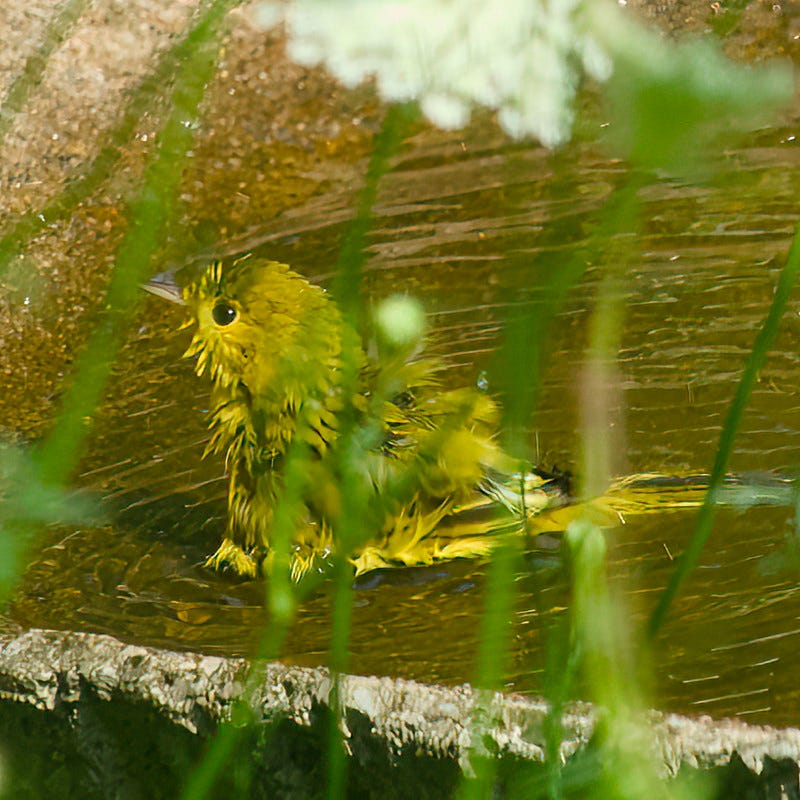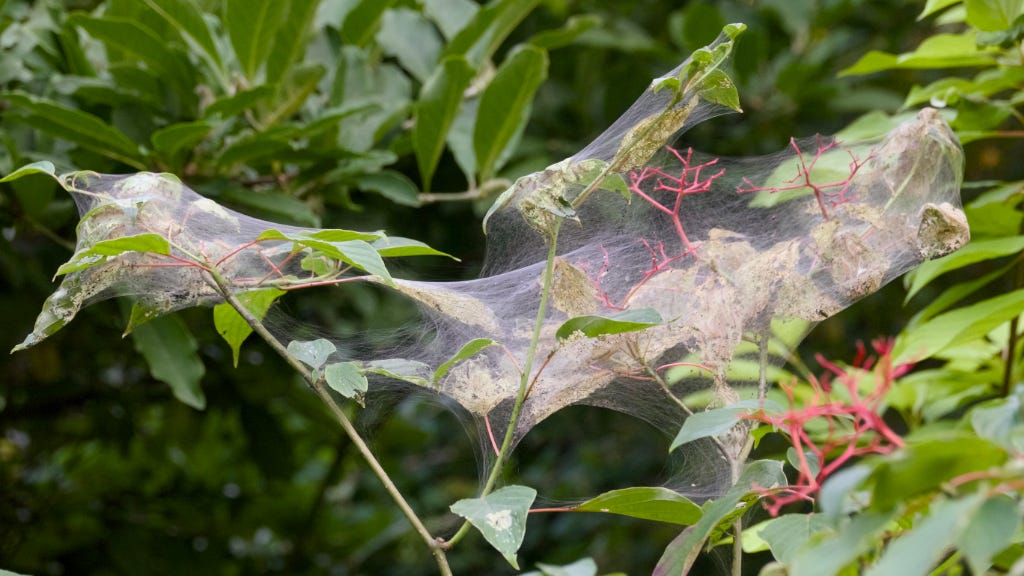CONTENTS
Just too hot - bathing birds
Plant Blindness
Fall Webworm Moths
Bees - more bees
Swarming Dragonflies
The week has been far too hot. Almost unbearably so, with humidex temperatures up to the very high thirties. It always used to be the case that in July/August we would get hot days but now we are suffering whole hot weeks piled one on top of the other. We can retreat indoors to air conditioning and cold drinks, but the plants and animals have no such recourse. We have a pond and a waterfall in the garden that is enjoyed by birds, especially in spring migration when they are heading north. We also have a good old-fashioned bird bath to which the occasional bird comes for a sip on a hot day - this year has been notable for the fact that birds have almost been lining up on perches in an adjacent sour cherry tree for their turn to splash around and cool off. American Robins are the keenest bathers by far, and repetitively so, but we were most interested this week to see a group of five Yellow Warblers visit for an extended bathing party. We usually see YEWAs individually, but not a group gathering like this.
NCC Bioblitz
We are engaged in quartering our local area as part of the NCC Bioblitz this week. An annual challenge run by Nature Conservation Canada. Next week I plan to have an article about what we have found in the garden and walking the roads and parks nearby. We were away last summer but in 2021 we recorded 215 assorted species and came 6th overall out of 1211 observers in Canada while in 2022 we recorded 259 species and came 7th out of 1782 observers. I doubt we will achieve such dizzy heights this year, it is simply too hot to spend the hours outdoors required, but we will have fun and do some good science along the way.
https://secure.natureconservancy.ca/site/SPageNavigator/BioBlitz_2024/BB_2024_content.html
Find out how we did in next week’s exciting installment of 1001 Species.
Thinking About Plant Blindness
Believe it or not, this section has been dramatically cut down in wordiness from its original draft version.
Our natural world is in trouble. We all know this. If ever society is going to decide that this is a problem we should address then it is important that society as a whole, people all together, are aware of the fact that biodiversity is under threat. In my experience, it’s not that so many people don’t care, rather that they don’t see a problem in the first place. Oh, we know there are fewer butterflies in summer and we perhaps notice that birdsong is less and less a constant background to our lives as we move around. But plants? How many of us see what is happening there - even when plants are so important to our existence? This inability to see a problem with the world of plants now has a name … it just that it doesn’t come with a solution.
"Plant blindness" is what it’s called. Plants in the surrounding environment are simply not seen other than as an amorphous green background. Inevitably, this means that there is a lack of awareness about plant conservation needs. The general (voting) public then tend to focus conservation efforts more on charismatic animal species, and neglect the protection and study of plant species that are equally endangered and, frankly, often more important.
It has been suggested that this blindness starts with an education system that unconsciously prioritizes animal biology over plant sciences and so people grow up with limited knowledge about plant diversity, physiology, and ecology. To say nothing of the fact that urbanization and digital lifestyles disconnect people from nature in general.
Ask yourself, what is the last animal you saw? Can you remember its colour, size and shape? Could you easily distinguish it from other animals? Now, how about the last plant you saw?
Studies have suggested that our brains search for visual cues to distinguish individual objects, and a background mass of green plants is just not as distinct as the shape of a moving animal. This is important. I had been peripherally aware of the problem, mostly because although I make no claims for being an expert in botanical matters, more and more I find that I am asked to help identify not only birds and insects but also some really common plants. While keen to help, quite often I ask myself how it is that someone has gone through life not knowing the name of a particular common plant of bird or whatever.
Often, I find, it’s not that people are not fundamentally interested in these matters, but that they feel overwhelmed by their lack of knowledge. Even thinking “how can I learn more” causes them to switch off, it all seems too much to take in. If access to basic identification and the ability to put a name to a plant (or bird) could be simplified then suddenly something can be sparked. I have seen this happen. I am not alone in doing what I can to show the natural world to neighbours and their kids. Today we have the internet and artificial intelligence to help - it’s not infallible yet but my oh my, how I wish I had had some of these tools fifty years ago. Just a smartphone with an appropriate app can open the eyes, draw back the curtain of plant blindness. PlantNet and iNaturalist are the ones I point people to first … and Merlin for bird identification. To really know something you must have its name.
PlantNet might help change people’s insensibility toward plant life, Bonnet hopes. “The fact that people are able to see the diversity, because they are able to name it, it’s not just a green wall – it starts to be something that is much more precise,” he says. “We are quite convinced that people who are aware about their environment will be much more efficient to manage it and to ideally protect it.”
In 2011, plants made up 57% of the federal endangered species list in the US. But they received less than 4% of federal endangered species funding. A similar pattern is probably seen in other countries. Building emotional connections with ecosystems and species and the plant as a whole is crucial for plant conservation.
Many of the readers of this newsletter, and of others like it, probably do have the necessary knowledge to help others break through the curtain and see what is happening. Whatever happened to the practice of schools and parents taking kids on nature walks? On simply taking yourself for a walk during which you pay attention and look at what’s around you. That would be a good place to begin. Catch them young.
https://www.theguardian.com/wellness/article/2024/jul/24/plant-identifcation-apps
Fall Webworm Moth Caterpillars
Commonly, but erroneously, known as the Tent-Moth, Hyphantria cunea is a really beautiful, pure white moth. A lovely thing. Its adult form is sadly preceded by its caterpillars which, if the infestation is bad enough, can defoliate areas of many hardwood trees in a quite short period, though mostly the trees survive the insult. The aggregation in these photos had set up in a pagoda dogwood tree earlier in the week …
The real Tent Moth caterpillars are several spring species of the genus Malacosoma. Those protect their caterpillars in a similar web-like structure but their tents are mostly found in the unions of tree branches while the Fall Webworm Moth caterpillars are a different species altogether and will concentrate at the tips of the branches. The webs present the advantage of allowing for the finding of mates when the adults emerge, for temperature regulation, increased growth rate, and protection from predators, but also result in higher rates of infections and predation. Nevertheless, a beneficial trade-off for the species survival as a whole.
Maine-ly Bees
You don’t always know when you need a new bee in your life. But nature knows, the bees know, and they’re out there just waiting for you to figure it out!
A Remarkable Swarm of Dragonflies
Quote: It’s been said that a dragonfly making the transformation from aquatic nymph to free-flying adult is a bit like a snapping turtle becoming a peregrine falcon.












